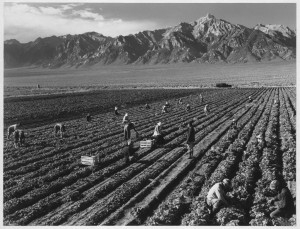Last week in class we were instructed to write an observation on one of the two images in our textbook on page 47. There was the painting: “Impressions: Sunrise” by Claude Monet from 1872. There was also a photograph by Ansel Adams from 1943. This photograph featured Japanese-American farm workers at a relocation center in California near Mount Williamson. I chose this photograph to observe and write about.
The stark contrasts of the rugged mountain range in the distance against the forefront of farm workers as they bent to their own toil truly caught my attention. I felt drawn into that vast landscape theme, that huge, craggy mountain in the distance, and endless rows of produce being tended by faceless workers. All of them appeared stooped and bent facing the fragile vegetation in the rows. I put myself in their shoes to describe the scene from a first person point of view.
‘My hands are cold to the bone. Chilled, yet they are still moving out of desperation. I pull and pull, stack and scoot, down the row while repeating this process over and over. The grey colors of my world are monotonous. I once glimpsed the mountains in the distance. I was shocked by the brief glimpses of periwinkle and charcoal that was shining through the grey mists. The wonder of the sheer blue sky lightened my spirit until the honking of the truck horn at the end of the lane brought me back down to this earth and this moment. My grey hands, covered in an even more grey tone of earth, pull the grey plants and stack them again and again in an endless grey pile. My linear motion down the rows seem never ending. A shadow falls over me adding to the bleak grey view of my existence. My reality is the black and white photo the cameraman is taking for the world to see.’
As I pull out of my nightmarish thoughts about this stark image, I wonder if these workers were forced into their labors, or if the work was provided for them at a living wage. How did they live? Did they have houses? Were they allowed to be with their families and children? I realize at this point that I know absolutely nothing about the Japanese American relocation camps that were formed after Japan bombed Pearl Harbor during World War II. I only have a vague knowledge that they were a reality.
As a society, we feel great scorn when we hear of the atrocities that were inflicted upon the Jewish peoples of Europe during Hitler’s reign of terror. We here of thousands and thousands of people that were corralled in various concentration camps there – and yet, we as a democratically governed country, simply allowed these things to happen on our own soil? I realize, or at least I fervently hope, that similar brutalities were not inflicted on these naturalized Japanese people on American soil. I hope that they were treated with respect even when our government feared terrorist like acts from within our own borders.




